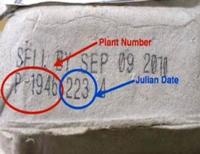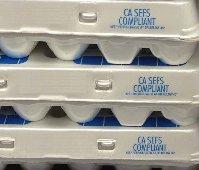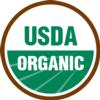

The sale of raw shell eggs sold from your property, at Certified Farmer's Market, grocery stores, restaurants and institutions are covered by this fact sheet. California Department of Food & Agriculture (CDFA) administers this program.

Visit CDFA's Small Producer Outreach Program page for upcoming workshops. COVID update: CDFA will be offering Zoom classes in the future.
Until USDA Create Rules
The following information applies to species as follows:
Chickens: grading, sizing, temperature controls and CASEFS Compliance.
ALL: Cleanliness, management claims, Egg Safety Rule and IRQ label requirements.
The following are requirements for Standard 12-18 egg cartons:

NOTE: when selling in bulk/allowing customers to choose individual eggs, the following information is required to be on a sign with the eggs:

Producers can email their label to CDFA for approval prior to use: CDFA.ESQM_Inquiries@cdfa.ca.gov
The terms cage free and pasture-raised are currently unregulated. USDA requires that in order to use the term free range, producers must demonstrate that the poultry have access to the outside. Labels that claim Certified Humane, Animal Welfare Approved and American Humane Certified all require certification from the respective organizations.
Organic:

the term Organic can only be used if the business/farm is registered organic through CDFA. Registration is regulated by California Department of Food Agriculture through the county Agricultural Commissioner's office.

Egg Grading refers to the exterior and interior of the egg. The eggs must be clean* and free of major defects on the outside as well as the inside. ALL eggs should be candled to identify any internal defects. Refer to the USDA Egg Grades & Standards for complete instructions.
Grade AA: The shell must be clean and unbroken. The air cell is limited to 1/8 inch depth at original and 3/16 inch at destination. The white must be clear and the yolk practically free of apparent defects.
Grade A: The shell must be clean and unbroken. The air cell is limited to 3/16 inch depth at original and 1/4 inch at destination. The white must be clear and the yolk practically free of apparent defects.
Grade B: The shell must be clean and unbroken and may have unlimited slight stains (but not dirt clinging to shell). The air cell may not exceed 3/8 inch. The white must be clear and the yolk practically free of apparent defects. The white may be weak and watery and the yolk outline plainly visible the yolk may appear dark, enlarged and flattened. It may show other serious defects which do not render the egg inedible.
Cleaning Eggs: eggs must be cleaned prior to sale. Submerging eggs is NOT recommended. Make sure eggs are dry before placing in carton. See this video from a small producer workshop with CDFA for Egg Safety including washing and candling eggs (starting at 31:20).
The grade of a shell egg is determined by the size of the internal air-cell. As an egg ages, the liquid contents evaporate through its pores. The larger the air-cell is, the lower the grade of the egg. The outside appearance also factors into the grade of an egg. Eggs with moderate staining (but not adhering dirt) can be sold as grade "B." All other grades require a clean, unblemished shell appearance. Dirty eggs cannot be sold to consumers. The size of an egg is determined by its weight, in grams. A small egg must weight 40.16 grams or more, a jumbo egg must weigh 68.51 grams or more.
Size tells you the minimum required weight of the smallest egg in the dozen. It does not refer to the dimensions of an egg or how big it looks. While some eggs in the carton may look slightly larger or smaller than the rest, it is the weight that determines the size indicated on the carton:
Min Weight
per Egg
NOTE: If you are unsure of the size of your eggs, label them the smallest size. For example, if you have at least medium sized eggs, label the carton as Medium. It is acceptable to have larger sized eggs in the carton.
Egg production falls under the Food & Drug Administration's Egg Safety Final Rule to prevent foodborne illness due to the consumption of eggs contaminated with the bacterium Salmonella Enteritidis.
The Egg Safety Final Rule applies to operations that do not process their eggs with some type of treatment (e.g. pasteurization) and have 3,000+ laying hens and/or handle 12,000+ cases per year (1 case = 30 dozen).
Small scale operations are 'exempt' from the inspections, but they are not exempt from following guidelines for food safety. "Small scale" =
The refrigeration regulations technically only apply to chicken eggs, however CDFA strongly encourages those who handle other eggs to follow the same refrigeration practices.
Per Cal Code (California Retail Food Code):
Raw shell eggs should be held at or below 45°F.
However, raw shell eggs may be stored and displayed without refrigeration if ALL of the following conditions are met:
Egg Cleaning Procedures for Small On-Farm Operations
0 BASKET SUBMERSION TYPE-(This machine is primarily used for on farm egg washing and Usually holds between four and ten gallons of solution.)
Disinfectants recommended by the USDA-APHIS that are effective against both HPAI and SE, and are more appropriate to the poultry house environment and high organic matter load in their "Biosecurity Guide for Poultry and Bird Owners" include:
In order for most disinfectants to work properly the object to be disinfected must be thoroughly cleaned and washed prior to being disinfected. Disinfectants should be applied using brushes, sponges, or spray units and appropriate contact times should be allowed (follow manufacturer's instructions).
There are many additional requirements for business operations. To get started, visit:
